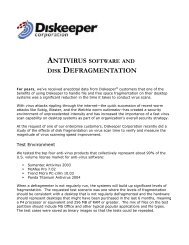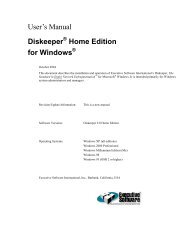Diskeeper 10 User's Manual
Diskeeper 10 User's Manual
Diskeeper 10 User's Manual
Create successful ePaper yourself
Turn your PDF publications into a flip-book with our unique Google optimized e-Paper software.
84 Glossary<br />
central processing unit (CPU): The part of the computer hardware that controls the computer’s overall<br />
operation and performs computations. Most modern CPUs are built into a single integrated circuit or chip. See<br />
also Pentium, x86.<br />
chip: See integrated circuit.<br />
CHKDSK: A program (supplied with Windows NT, Windows 2000, Windows XP, and Windows Server<br />
2003) that checks the integrity of a disk and corrects disk errors such as lost clusters. See also scandisk.<br />
client: In a computer network, a computer that uses the services of another computer, called a server. For<br />
example, a client can “ask” a server to provide it with needed data, or to print a file for the client. See also<br />
server, workstation.<br />
cluster: Smallest addressable unit of space on a disk. A one-byte file will actually use a cluster of disk space.<br />
The minimum size of a cluster depends on the size of the disk volume. The FAT file system allows a maximum<br />
of 65,536 clusters per volume, which means that the cluster size on a 64-megabyte disk volume is one kilobyte,<br />
while a 128-megabyte volume uses two-kilobyte clusters. Thus, the FAT file system can be very wasteful of<br />
disk space on large volumes. The NTFS file system does not suffer from this limitation.<br />
COM: Acronym for Component Object Model, a specification developed by Microsoft for building software<br />
components that can be made into programs or add functionality to existing programs running on Microsoft<br />
Windows platforms.<br />
component: A small modular program that performs a specific function and is designed to work interactively<br />
with other components and applications. See also applet, COM.<br />
contiguous: Adjacent; placed one after the other. A contiguous file is not fragmented; that is, it takes up a<br />
single “chunk” of disk space. See also fragmentation, defragmentation.<br />
control file: A file (Diskeep.ctl) used by <strong>Diskeeper</strong> to keep track of and control scheduled defragmentation of<br />
disk volumes. See also Set It and Forget It.<br />
controller: A specialized electronic circuit, which serves as an interface between a device, such as a disk drive,<br />
and a computer. See also IDE, SCSI.<br />
CPU: see central processing unit.<br />
data: Information, as processed by a computer. Plural of the Latin word datum, meaning an item of<br />
information.<br />
database: A collection of related information about a subject, organized in a useful manner that provides a base<br />
or foundation for procedures such as retrieving information, drawing conclusions, and making decisions.<br />
datum: Singular of data.<br />
defragmentation: The reduction or elimination of fragmentation, by making files and/or free disk space more<br />
contiguous.<br />
device: A machine, such as a printer or a disk drive.<br />
digit: From Latin “digitus,” meaning finger. Any of the numbers 0 through 9 in the decimal number system,<br />
called a digit because people originally used their fingers for counting. Computers use a binary number system<br />
with only two digits (0 and 1).<br />
directory: A file that contains a catalog of files and other directories stored on a disk, which allows you to<br />
organize your files into groups, making them easier to find.<br />
directory consolidation: A <strong>Diskeeper</strong> feature which, at boot-time, gathers (almost) all directory entries on a<br />
disk volume into a single area on the disk, instead of scattered in many places. Directory consolidation makes<br />
defragmentation more effective than it would otherwise be. Directory consolidation requires sufficient<br />
contiguous free disk space into which the directories can be moved.<br />
disk drive: A device containing one or more disks, treated as a unit by a computer.






